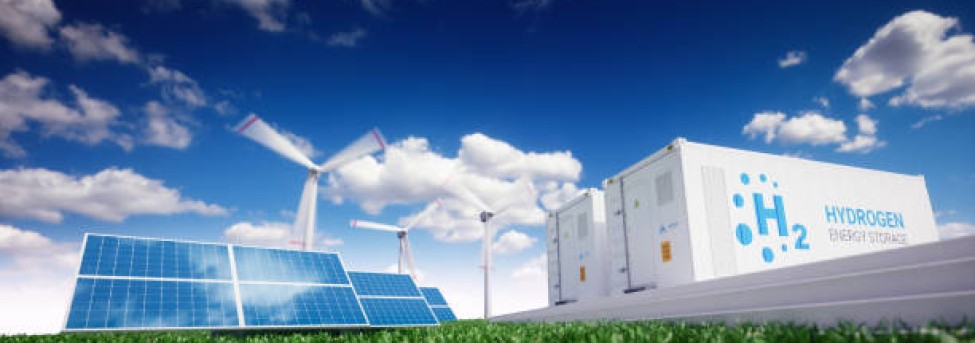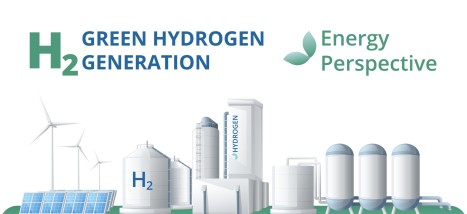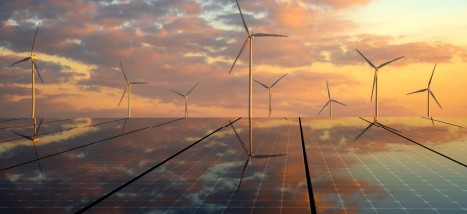-
21 September 2023

Green hydrogen, how sustainable can it become?
Hydrogen is often mentioned when it comes to the solution for mobility, heating and industry. But what exactly is it? How sustainable is it and how sustainable can we make it?
Hydrogen is the most abundant element in the universe. Under normal circumstances it is gaseous and we speak of hydrogen gas (H2). Hydrogen is also the lightest gas we know, but under high pressure it has a high energy density of 120 megajoules (MJ). That is almost three times as much as natural gas (45 MJ per kg). However, pressurizing (compressing) hydrogen gas also costs the necessary energy (about 10%).
Green hydrogen, also called 'renewable hydrogen', is hydrogen that comes from a renewable source and is produced with sustainable energy. The two main sources of green hydrogen are water (extraction through sustainable electrolysis in which water (H2O) is split into hydrogen (H2) and oxygen (O2)) and biomass via green electricity. Another option is to convert sustainable energy from wind and sun directly into hydrogen. A wind turbine that directly supplies hydrogen would be ideal.
Unfortunately, most hydrogen is still produced using fossil fuels. Virtually all hydrogen that is currently produced worldwide is so-called 'grey hydrogen'. Production is currently done via Steam Methane Reforming (SMR). Here, high-pressure steam (H2O) reacts with natural gas (CH4), resulting in hydrogen (H2) and the greenhouse gas CO2. In the Netherlands, approximately 0.8 million tons of H2 is produced in this way, for which four billion cubic meters of natural gas is used and results in CO2 emissions of 12.5 million tons.
Israeli startup H2Pro recently raised 22 million for the construction of a new type of electrolyser. This can make cheap hydrogen from water and sustainable electricity; according to the company, the technology can ensure that green hydrogen costs one dollar per kilogram by 2030. The company therefore expects that their new factory can facilitate that major breakthrough: large-scale hydrogen production for much less money than it currently costs.
Although companies and governments would like to see a large increase in the production of sustainable hydrogen, unfortunately the practice has not yet been able to fulfill this expectation. Green hydrogen is currently two to six times more expensive than fossil hydrogen. There are still too few high-power electrolysers in the world and too little sustainable power to run them. In that respect, the solution is simple: generate more high-power electrolysers and much more sustainable energy!
The technical solution of H2Pro ensures that one of the more expensive parts in a classic electrolyser, the membrane, is no longer necessary, but the end result is the same. The process is also more efficient, converting 95 percent of the energy from used electricity into hydrogen instead of 60 to 70 percent in current installations, although that productivity is also likely to improve in the future.
If green electricity is readily available and the price drops (for example if there is a strong wind or if there is a lot of sun, or if there are simply many more sustainable energy generation installations), this efficient system can already supply green hydrogen for a dollar per kilo in 2030. That is many times cheaper than green hydrogen is now (2.50 to 6 dollars per kilo). It is about as expensive as hydrogen made from fossil fuels.
In our current energy mix, approximately 20% is supplied in the form of electricity and 80% in the form of natural gas or liquid fossil fuels (petrol, diesel). Due to our climate objectives, this will change significantly in the near future. The share of electricity produced by wind and solar will increase sharply. For a number of applications such as heavy transport, high temperature processes in industry and in aviation, there is not yet a good electrical solution and there is still a need for a sustainable gas. Hydrogen can play a useful role here. In addition, hydrogen is important in the form of large-scale storage for the moments when there is no wind and cloudy.
Hydrogen is therefore certainly a solution for future challenges. How realistic and, above all, cost-effective the green variant will become, partly depends on the growth of green electricity. Major investments in sustainable energy generation from, among other things, wind (see also WindShareFund) and solar, are and will remain hugely important, not least for the production of green hydrogen. With FutureEnergyFund, the somewhat larger investor can already invest in the development of green hydrogen.
Sources:
- TNO.nl
- Change.inc
-
25 March 2025
 Green hydrogen can contribute effectively to emissions reductionBy: Evertjan van Roekel
Green hydrogen can contribute effectively to emissions reductionBy: Evertjan van RoekelGreen hydrogen often, but certainly not always, leads to CO2 gains. This is evident from research in Nature Energy by Kiane de Kleijne of Radboud University and Eindhoven University of Technology. 'If you calculate the entire life cycle of green hydrogen production and transport, the CO2 gain can be disappointing. But if green hydrogen is produced from very clean electricity and in the region, it can really contribute to emission reductions.'
[Read more...] -
18 February 2025
 Renewable energy investment creates great potentialBy: Evertjan van Roekel
Renewable energy investment creates great potentialBy: Evertjan van RoekelAn investment in renewable energy offers an excellent financial return and a way to put your money to work for people and the environment. Sustainable energy investments also play a crucial role in tackling the global climate problem.
[Read more...]